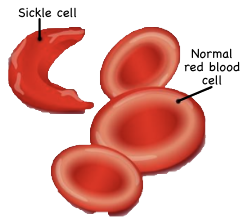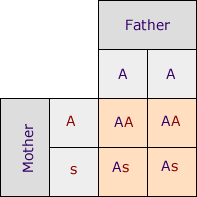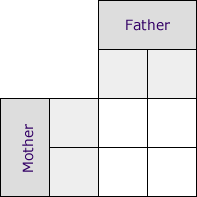Punnett Square for Sickle Cell disease and theoretical and experimental probability
In the United States about 100,000 people have the Sickle Cell disease and 2.5 million have sickle cell traits. Source Center for Disease Control
Sickle cell disease is traced to one gene. The gene that makes hemoglobin. In the case of sickle cell the gene makes sickle-shaped red blood cells instead of normal round cells. The shape of thes cells cause pain and organ damage as they move through the body. One example is Acute chest syndrome (ACS) is severe as sickle cells damage the lung tissue as they move through them. Currently there is no treatment options for ACS. However, genetic deletion and replacement of sickle cell genes could be used to prevent sickle cell.
Explore the genetic nature with the following activities.

Background vocabulary:
Chromosomes is a deoxyribonucleic acid (DNA) molecule that has part of the genetic material of a human. Humans have 46 chromosomes, 23 pairs with one chromosome from dad and one from mom for each pair. Making two alleles for every gene.
Chromatin the material (protein, RNA, and DNA) of which the chromosomes are composed.
Genes are made of DNA. Humans genes range from a few hundred DNA bases to more than 2 million bases. A human chromosome can have up to 500 million base pairs of DNA with thousands of genes. The DNA that make a gene is a sequence of instructions that determine your traits: your hair color, eye color, skin color, or if a person gets the sickle cell disease.
Allele is a form of the gene responsible for a hereditary variation. At least one allele from each parent (sometimes more).
Phenotype is what you actually get expressed, or produced from expressing the gene/alleles. Like: eye color, height, hair color, or anything, even different proteins. v
Probability is determined in one of two ways: theoretical and experimental. Either way: the probability of an outcome is the number of specific outcomes out of the total number of all possible outcomes of one event.
Genome is the complete set of genes (consisting of chromosomes made of DNA) in the cell.
Genotype is the alleles in an organism that determine a trait.
Activities
Goal: Compare the theoretical probability of a child being born with sickle cell disease to the experimental probability of a child being born with sickle cell disease.
Enjoy!
Theoretical probability
Background information: Children always inherit one allele from each parent and the two together determine the child's genetic makeup and the results of the child's phenotype.
Describe all the possible ways two alleles might combine for example: dark hair (D) and light hair (l).
Background information:
- Let A represent an allele that makes normal red blood cells
- Let s represent an allele that makes sickle cells
Will also combine in the same possible ways: AA, As, sA, ss.
Which will result in these possible results (genotypes or phenotypes).
- A gene with AA will make normal red blood cells and will not pass on the sickle cell allele.
- A gene with As will make normal red blood cells and can pass on the sickle cell allele.
- A gene with ss will make sickle cells and can pass on the sickle cell allele.
Use the information to describe theoretical probabilities for a child born from two parents with the following alleles.

What is the probability of these parents having a child with sickle cell?
What is the probability of these parents not having a child with sickle cell?
What is the probability of these parents not passing on the allele for sickle cell to their children?
What is the probability of these parent passing on the allele for sickle cell to their children?
Use the Punnett squares to show other theoretical possibilities?



Experimental probability
Use the information you have learned along with the following information and complete the following.
- We will use the same alleles from our previous parents (Father AA & Mother As).
- Since the father will always contribute an A allele, they have been entered in the chart below.
- Use a coin or a die to determine the alleles passed to a child from a mother. For example: Flip a coin and let heads be A and tail be s. Flip and write the allele trait in the chart below.
- Repeat the process for 19 more times.
- Insert the child's phenotype or genotype)
- Use the data to answer the discussion questions about the possible genotypes.
| Mother | Father | Child |
|---|---|---|
| A | ||
| A | ||
| A | ||
| A | ||
| A | ||
| A | ||
| A | ||
| A | ||
| A | ||
| A | ||
| A | ||
| A | ||
| A | ||
| A | ||
| A | ||
| A | ||
| A | ||
| A | ||
| A | ||
| A |
Hint: you can multiple the total for each genotype by 5 to find the %.
What is the experimental probability of these parents having a child with sickle cell?
What is the probability of these parents not having a child with sickle cell?
What is the probability of these parents not passing on the allele for sickle cell to their children?
What is the probability of these parent passing on the allele for sickle cell to their children?
Discussion:
In the theoretical probability the result (AA or As; 50% AA or 50% As) was certain. In the Experimental the probability can change.
How much do you think the probability might change from the theoretical?
Why?
Which genotype is more favorable in reducing the probability of a child being born with sickle cell disease?
Are there any parental genotypes that guarantee all children will be born with sickle cell disease?
As a parent what would you want to consider if a sickle cell disease is a possibility for your offspring?
What is the difference between the theoretical probability and the experimental findings?
Why is there a difference?
Check your understanding of probability with this probability rubric
Last edited - July 28, 2025